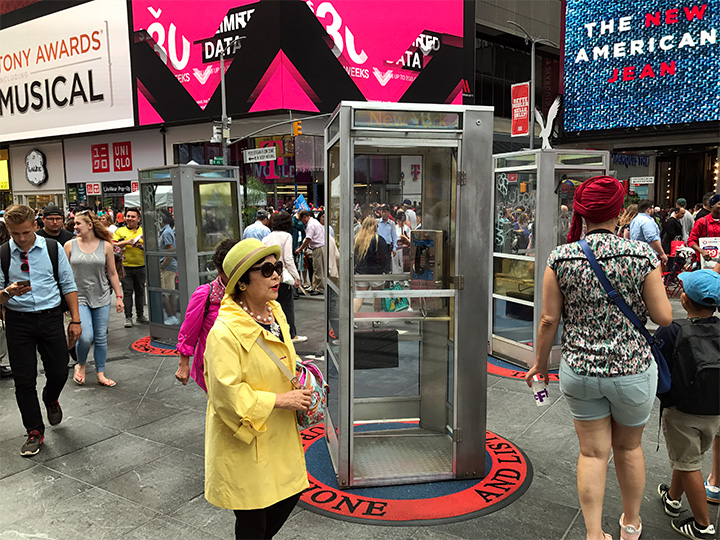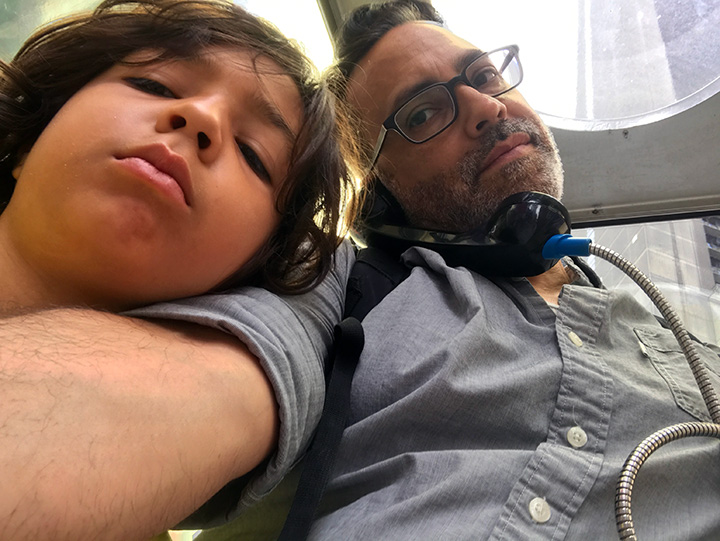Archive for August, 2017
Realidad VE
Realidad VE is a small experiment that attempts to combine documentary material with virtual space for VR presentation.
Last fall I had an extended interview with José Bergher a retired professor and classically trained musician from Venezuela who was the director of the Symphony Orchestra of Venezuela. Throughout his professional career he worked between New York City and Caracas and the reason behind the interview was to learn about that dual citizenry – about living between cultures and floating from one part of the world to the other. However as the interview progressed, I asked José about the current state of Venezuela – politically, economically and the common problems that people face day to day. He replied with a 20 minute discussion of the rise of Chavez and the current power-grab by Maduro and the lasting influence of Fidel Castro.
I knew that this discussion would not be appropriate for the project that I was working on, but I appreciate his first-hand perspective and given the last several weeks in Venezuela, I wanted to present his voice in a unique format. Entirely based on my news consumption of current protests, clashes and seemingly general instability in Venezuela, I created a blank world with the exception of dead trees and abandoned drilling rigs. The world is populated by men and women running across the space. A boy sits against a tree taking in the world around him. At another spot a young couple argues and elsewhere two friends are in discussion. Along the entire perimeter paramilitary troops stand guard and watch the space. At a couple spots trios of soldiers have friendly discussions. In this world, the military is at ease, though watchful whereas the people appear frantic.
I’m interested in combining documentary material such as the interview with José Bergher with virtual space and employing virtual reality as a platform for documentary. Jose’s discussion of current Venezuelan politics presented an opportunity for experimentation. Pictured above is the project for installation that features an animated José Bergher above the virtual space, the project is online with out Bergher’s video, only his voice accompanies the virtual space as the inclusion of video made an already long load time much longer.
“Once Upon a Place” at Time Square

“Once Upon a Place” by Aman Mojadidi at Time Square
Repurposed public phone booths are a poor vehicle for the sharing of immigrant stories. As an artist largely dedicated to reflecting upon migrant populations and cultural dislocation, as soon as I heard about Aman Mojadidi’s “Once Upon a Place”, installed at Time Square, I knew that I needed to visit the project. I worked out a deal with my son and hauled him up to Time Square. Upon entering Duffy Square, we encountered three old phone booths sitting on red and blue carpets with phrases such as “Global Stories” along the circular perimeter.
The first one I entered did not appear to function. I picked up the receiver, put it to my ear and heard only silence. I searched for instructions on the phone as I pushed the numerical keypad, nothing. I pulled out the phone book hanging below a steel shelf, but there was no information as to how to activate the phone. I considered putting coins in the slot, but didn’t have any. So then I stepped out, and read the signage for the project, still no instructions. At this point, the other phones were empty so I tried a second phone booth.
Upon putting the receiver to my ear, I heard the voice of a woman. She was from Mexico and she was describing the hardships and poverty of her home town. The story was brief. She was followed by a man from West Africa, I do not recall the country. He has well explained his desire for a new life due to the intense poverty of his upbringing. The next man, if I recall correctly was Dominican and he explained how his entire family had immigrated to the United States. He was left alone in his country, so he felt that he had little choice but to migrate to the United States…
I believe that the reason that I don’t recall details from these personal stories, besides the fact that it was hot and uncomfortable in the phone booth, is that they were not very interesting. The use of the repurposed phone booth to share immigrant tales is clever (though I don’t recall and can’t imagine a phone booth ever being a popular means to call family across borders), but the framing and presentation of the content does not make the work compelling. Ultimately, the work relies on the strength of the subjects the artist has captured and the artist’s capability to steer the conversation or interview and stir nuance from the subject. The three subjects (of 70) that I listened to were not engaging story tellers. Their experiences were sad and clearly state the need to escape a harsh reality and yet they did not summon empathy or any emotional reaction in me.
However, my time with the project was cut short, by a bored nine year old, who started tapping down the phone’s hookswitch and with each tap the voice from the receiver would go silent. The recording would not pause as when he lifted the hookswitch and I heard the voice again, it did not begin from the stopping point, but rather the audio was continual. So once we were both frustrated, I relented to his desire to move on.
We sat in the stands over looking Duffy Square and ate lunch. I continued to observe the installation. Sadly there was very little interest in the project from the throngs of tourists on a summer Saturday afternoon as the phone booths remained largely empty. Occasionally a curious tourist would poke her head in, listen for a few seconds and then walk out.
My take away from interacting with the installation and observing the public interest: a multitude of stories or interviews, apparently a total of 70, does not generate an interesting project. A single compelling story teller is more significant than many interviewees. Secondly, I found the combination of the immediate surroundings and the heat within the phone booth too distracting to focus on the audio for very long. Time Square is not a good location for audio installations that rely upon focused engagement. Lastly, I’ve got to stop taking my son to see art work that I wish to engage with for any extended period of time. Perhaps, I’ll go back at night by myself and have a different experience.

Sharing the phone at Aman Mojadidi’s “Once Upon A Place”
The installation commissioned by Time Square Arts will continue to be available until September 5th at Duffy Square – West 46th Street and Seventh Avenue.
